
Are your porch columns old or simply unsightly? It might be time to refresh them. Here's a breakdown of the cost of replacing porch columns.
Deck out your yard without going overboard


The average deck is between 300 and 400 square feet, but the size depends on your home’s square footage and your yard size.
A general rule of thumb is for a deck to be no larger than 20% of your home’s square footage.
Consider local setback laws and what you want to use your deck for when deciding on a deck size.
Consider your yard size carefully when deciding on a deck size, and note that oversized decks can detract from your property value.
So, you’ve decided to build a deck in your yard to boost your enjoyment of the outdoors. You’re taking a big step toward backyard bliss, but what deck size is appropriate for your home? Understanding what size deck you should install can ensure you get maximum use out of your deck and your yard without the structure looking out of place or detracting from your home value.
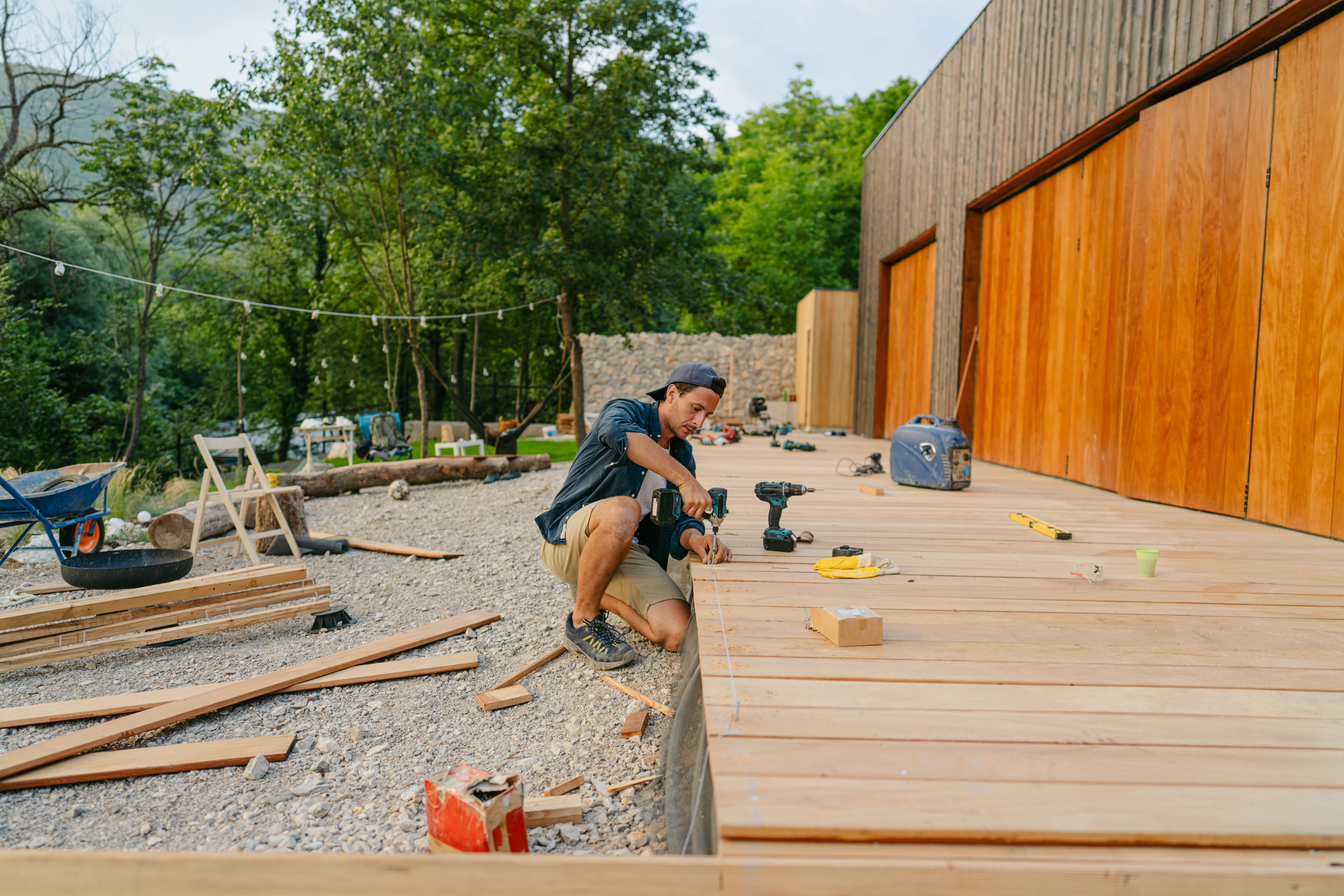
The average deck size is between 300 and 400 square feet, with specific dimensions depending on the yard size and shape. An 18-by-18-foot or 20-by-20-foot deck is most common for square decks, while 15-by-20-foot and 18-by-20-foot decks are the most common dimensions for rectangular decks.
However, overall deck size can range from 100 square feet to 500 square feet or more, and dimensions vary widely within those ranges. Speak with a professional who builds decks to get proper dimensions for your project.
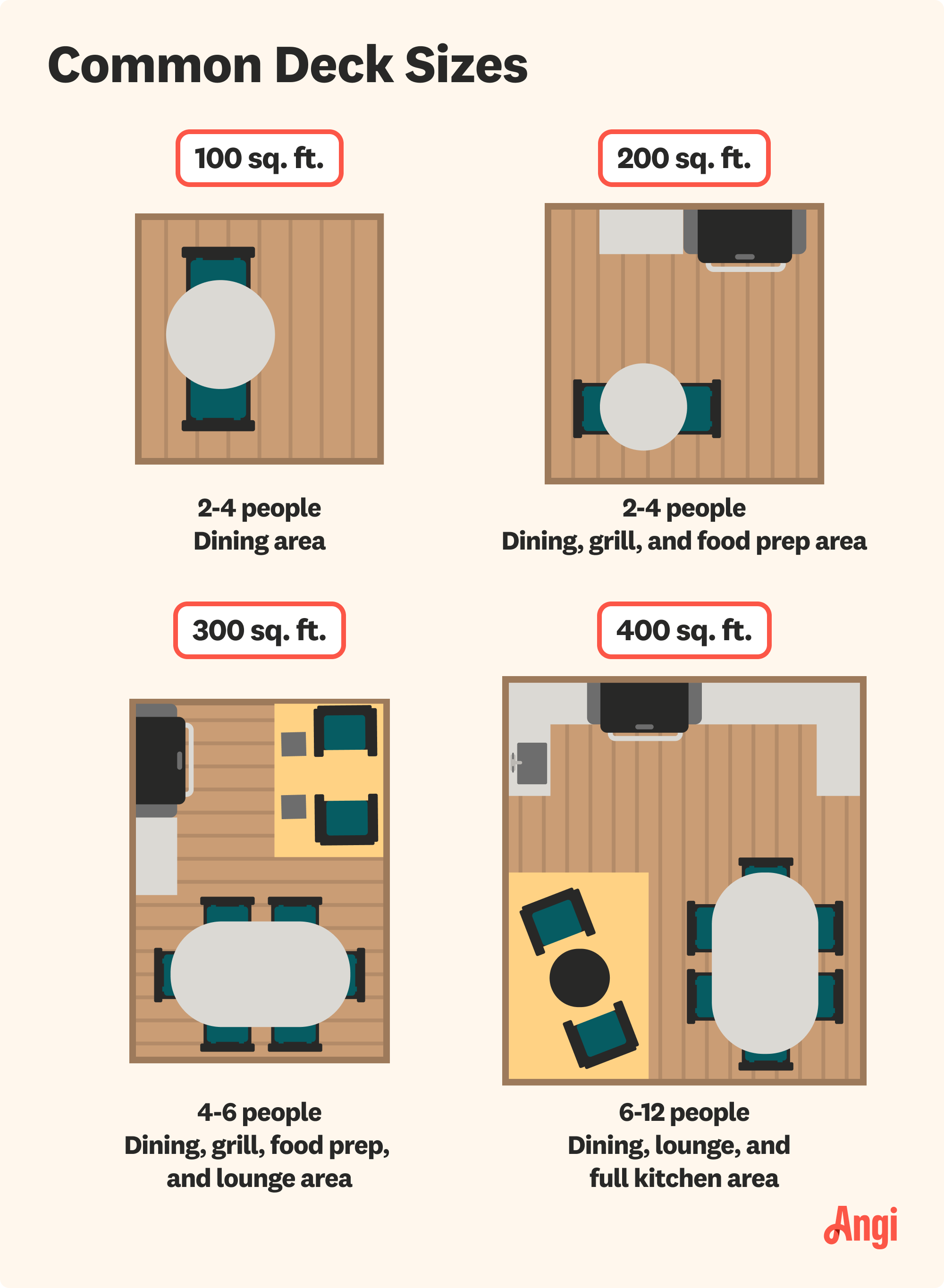
One of the first things most homeowners consider when deciding on a deck size is how they plan on using the deck. Most people will start with a vision of the type of deck they need to get the most enjoyment out of the space, and the room required for that purpose will dictate dimensions to some degree.
| Deck Square Footage | Size | Purpose |
|---|---|---|
| 100 | Small | Dining for 2–4 |
| 200 | Medium | Dining & prep |
| 300 | Medium | Dining & lounge area |
| 400 | Large | Full kitchen/lounge |
If your dreams about backyard enjoyment just involve a place for two to four people to relax after a hard day of work or gather for small outdoor meals, then a deck that’s around 100 square feet will do nicely. You can either have a small table that seats up to four or a lounge area with a loveseat and two lounge chairs, plus a coffee table or a small outdoor bartop.
Aim for a 200-square-foot deck if you want a dining area for two to four people, plus room for a grill and a small food prep station. The dimensions also matter here, so be sure to consider both the total deck size and the dimensions and deck shape.
You’ll need a deck that’s around 300 square feet if you want room for a dining area that seats four to six, plus a lounge area that can seat an additional four to six people or serve as an alternative and more comfortable place to relax after your outdoor meal.
Finally, if you want an outdoor space large enough to entertain a larger party of six to 12 people, you should aim for a deck that’s 400 square feet or larger. This can include a bigger dining table, a standalone lounge area, a full outdoor kitchen, and other features, like a fire pit table or outdoor bar.
There’s such a wide range in standard deck sizes because there are a few important factors that affect how big or small you should go with your deck.
You should base your deck size, at least in part, on your home’s square footage. It’s a good idea not to install a deck that’s equal to no more than 20% of your living area, which means 200 square feet of deck for every 1,000 square feet of interior living space. This helps keep the proportion of your deck to your home within reason, as oversized decks can look out of place if they dwarf your home size.
On the other end of the spectrum, a small, 100-square-foot deck may look out of place on a 3,000-square-foot home set on a large piece of property. You want to balance your deck size with the size of your main structure, so aim for between 10% and 20% of your home’s square footage.
| Home Size (Sq. Ft.) | Max Deck Size (Sq. Ft.) | Common Sizes (Ft.) |
|---|---|---|
| 1,000 | 200 | 10-by-20, 12-by-15, 14-by-14 |
| 1,500 | 300 | 12-by-25, 15-by-20 |
| 2,000 | 400 | 18-by-20, 15-by-25, 20-by-20 |
| 2,500 | 500 | 20-by-20, 20-by-25 |
| 3,000 | 600 | 20-by-30, 25-by-25 |
The layout of your house matters when sizing your deck, as well. Large, sprawling decks will look more appropriate on a 2,000-square-foot ranch-style home spread out over a large footprint than on a two-story home with a similar square footage. The reverse is also true: a small deck will look out of place attached to a wide-set ranch, while it might look normal on a two-story home with a similar square footage but a smaller footprint.
The dimensions of your home will also determine the dimensions of your deck. Standard homes are wider than they are deep, so decks will more often either be square or have longer dimensions from side to side. In areas with slim but deep plots, you may find otherwise unusual deck dimensions that span backward to make use of the deep yard while leaving room on either side for walkways to the yard behind the deck.
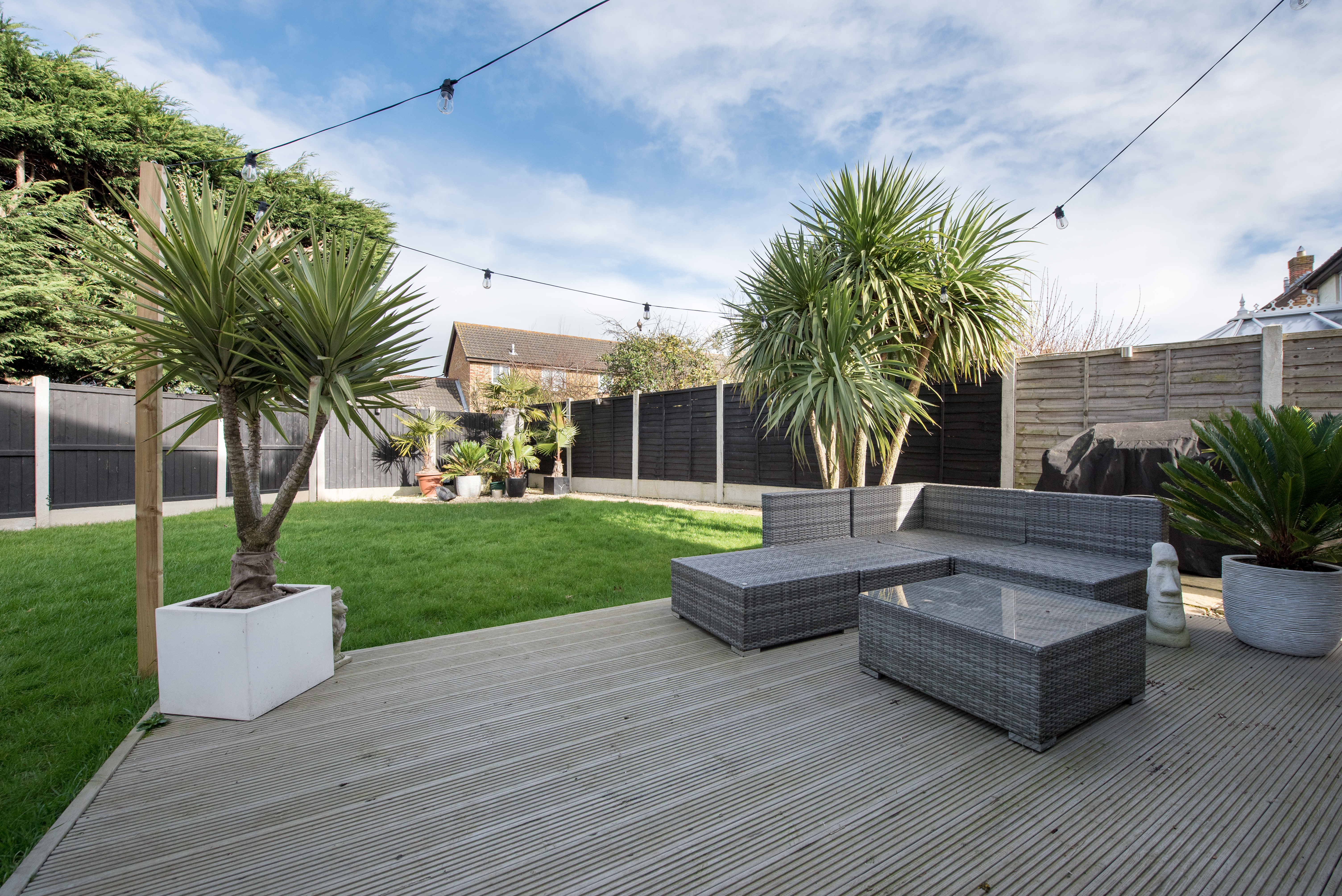
The size of your yard matters, too, as your deck will take up a portion of your yard or cover it, as in the case of a second-story deck. Another good rule of thumb is to aim for no more than 10% of your yard size for backyards that are 5,000 square feet or more and no more than 20% for smaller yards. That puts your deck size at 500 square feet or less for larger properties and keeps decks in smaller yards in proportion.
Not only is taking up too much usable yard space with an oversized deck sometimes a deterrent for buyers, but it can also mean running into issues with setback laws for smaller yards. Be sure to hire a deck builder near you to size your deck properly and ensure it’s built to code.
Finally, consider the climate in your area. In warmer and more moderate climates, where you can get a lot of use out of a backyard entertainment area, it may be worth it to install a larger deck, keeping within the general sizing rules mentioned above. You’ll pay more in deck installation costs, but you’ll get more value from it, and buyers are more likely to see greater value in formal outdoor entertainment areas.
In colder climates, a deck won’t add as much value for you or for buyers because there’s less time each year that you can enjoy the outdoors. Consider going smaller in more extreme climates to balance cost and value.
If you have an existing deck that feels too small for your needs or for your property, you can contact a local deck builder and ask them to build an extension for you. It may be challenging to match the materials, and you’ll likely have to pay to repaint or refinish your deck to get a consistent look and color, but deck refinishing costs will pale in comparison to removing the old deck and installing an entirely new one.
If your deck seems too large for your needs or looks out of place in your yard due to its large size, a deck pro may be able to downsize it for you without removing it entirely. The job will be intensive and may require moving supports and reframing parts of the deck, but your cost will, again, be lower than removing and replacing.
Alternatively, you can pay to replace your deck with a proper size. This is the most expensive option in most cases, but it’s an especially good route to go if your old deck is rotting or beyond repair, or if you want to change the location of the deck along with the size, dimensions, or shape.
Mayflower was an excellent choice for the complete renovation of my condominium. They knew exactly how to deal with the complexities of the condo building and management to make the project very smooth, easy and done right. From start to finish, everyone was incredibly helpful and their...
Alex and his crew are great! I contracted them to move my dad and they went above and beyond!
Excellent sales staff and installer. Easy to work with. I appreciated that my current system was able to be activated and used.
It was done in less than 15 minutes, even going back and forth for tools, and was quick and painless.
From average costs to expert advice, get all the answers you need to get your job done.

Are your porch columns old or simply unsightly? It might be time to refresh them. Here's a breakdown of the cost of replacing porch columns.

Cedar is a popular decking material, best known for its natural wooden look and resistance to rot. So, how much does a cedar deck cost? Find out in this guide.
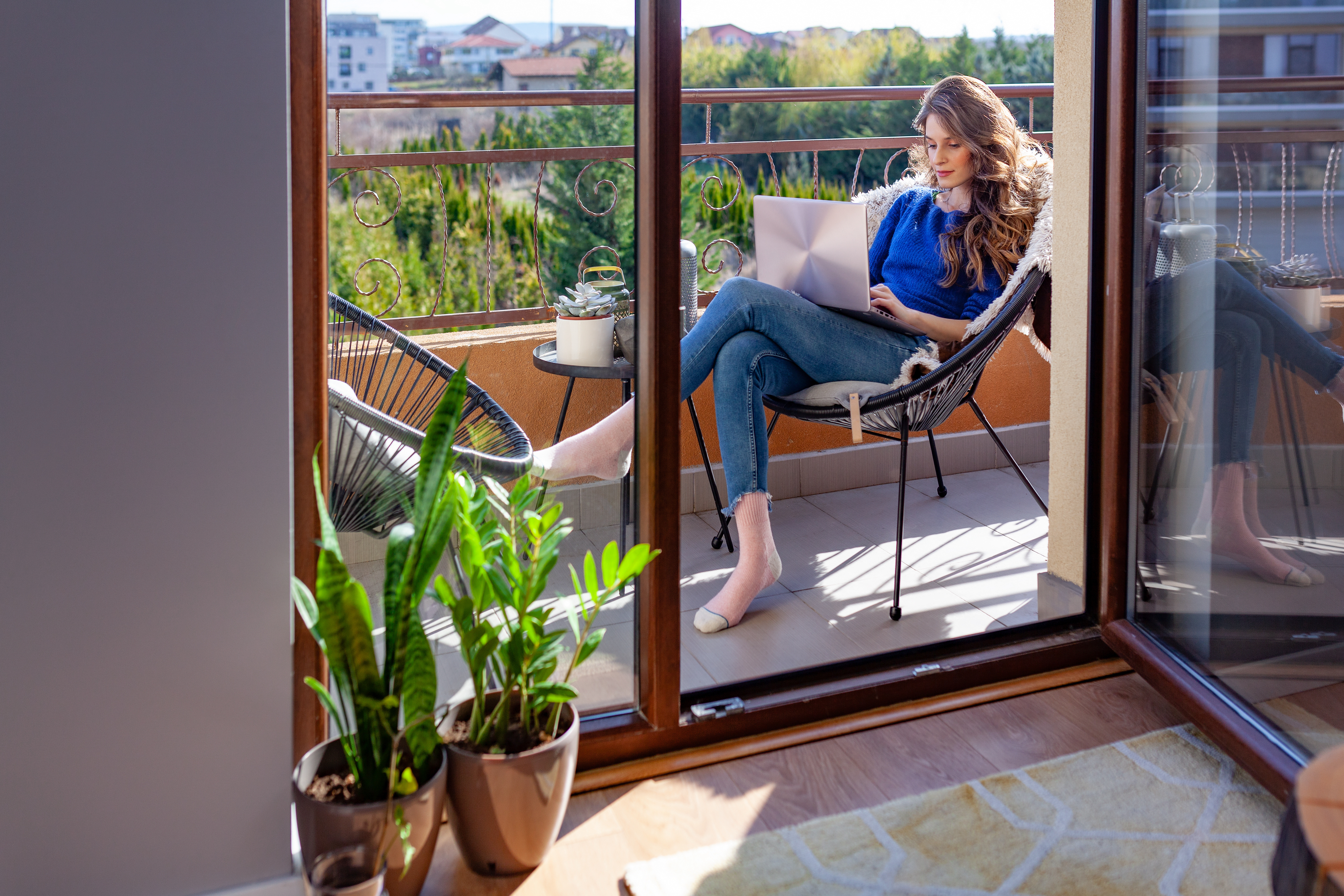
Discover how much it costs to build a balcony, including average prices, cost factors, and tips to budget your project. Learn what impacts balcony construction costs.

Decks provide usable outdoor space for relaxing and entertaining. But do decks add value to a home? Find out the answer in this informative guide.

Nothing ruins outdoor ambiance like a greenish deck. Discover why your deck turns green and find some straightforward solutions to fix and prevent the issue.
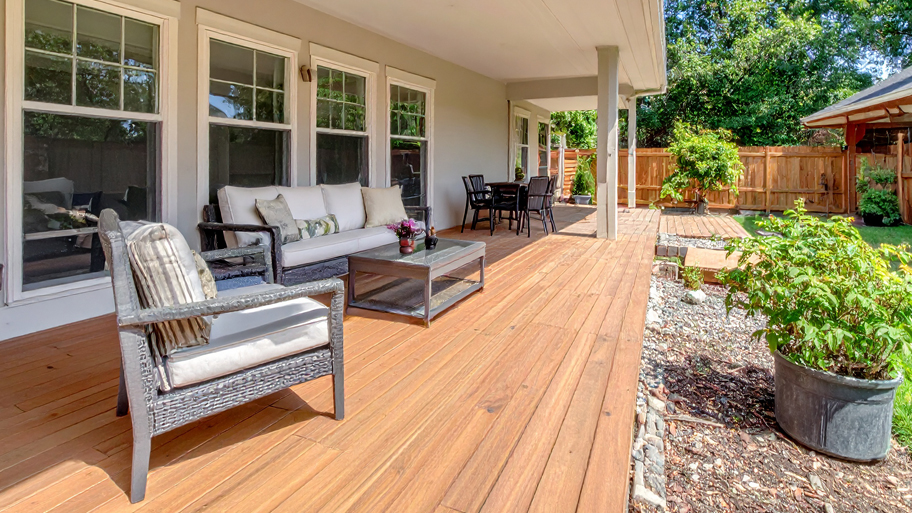
Homeowners are turning to pressure treatment to shield their wood from the elements and pesky insects. Discover how much longer you can make your wood last.